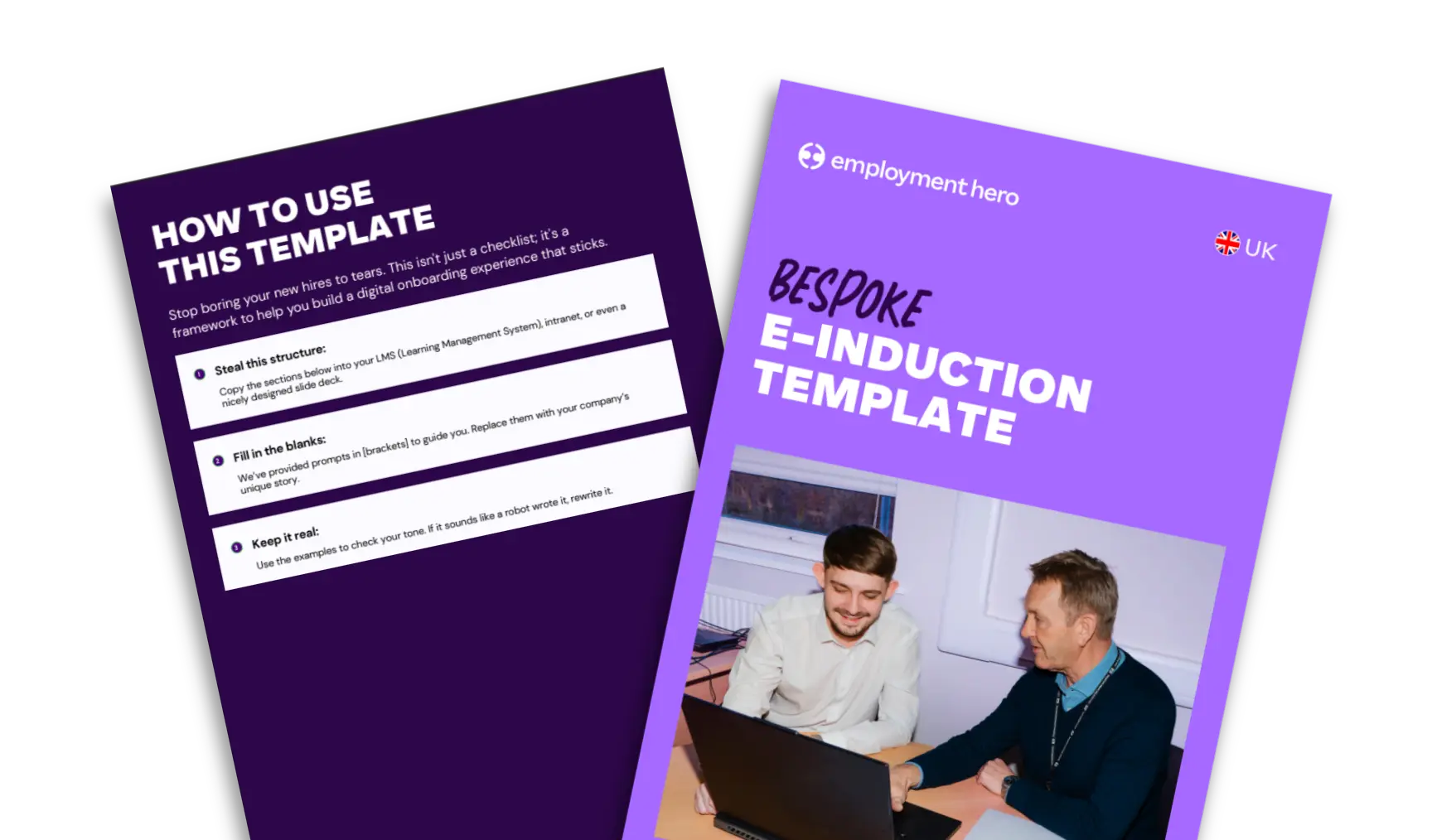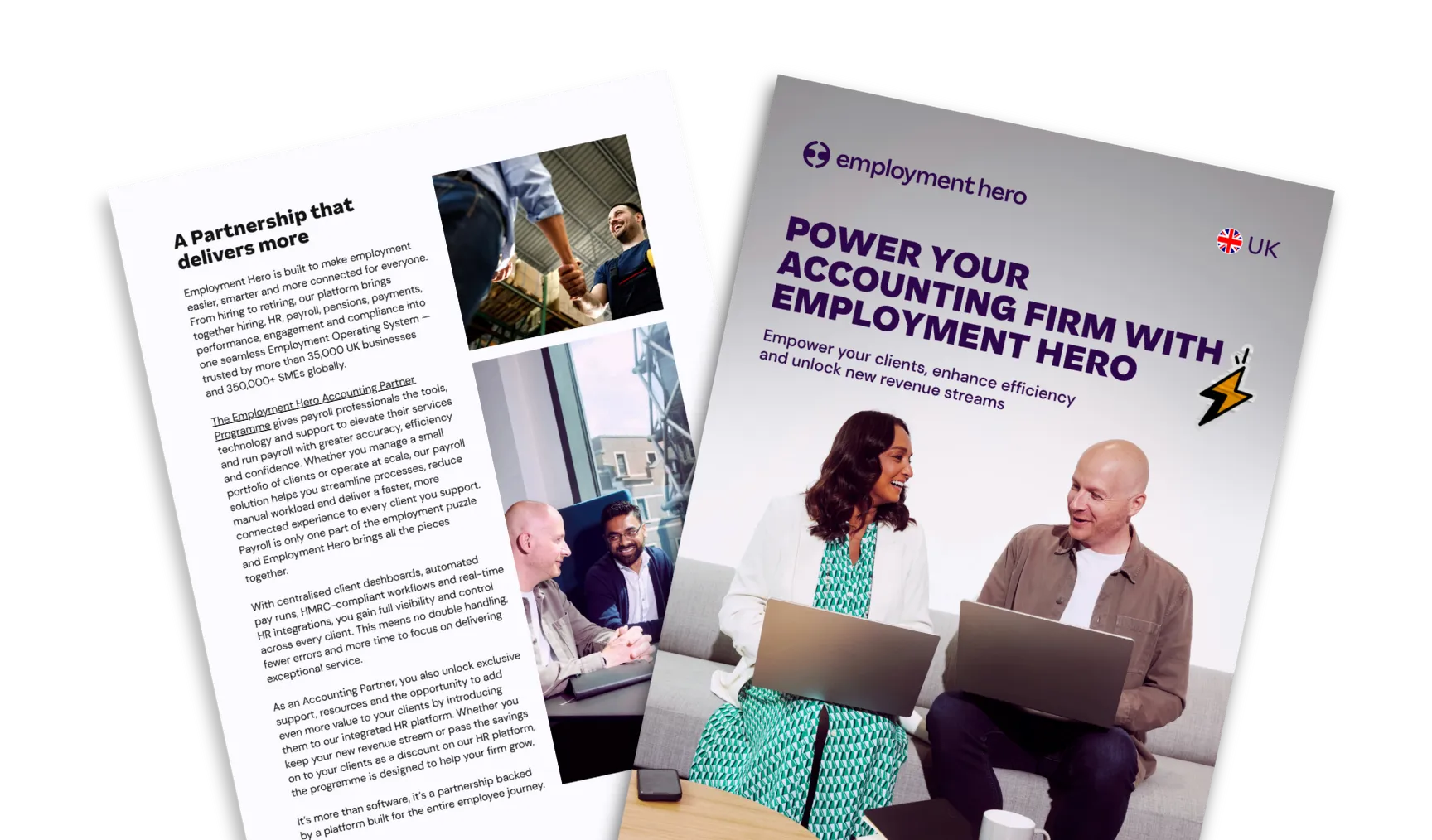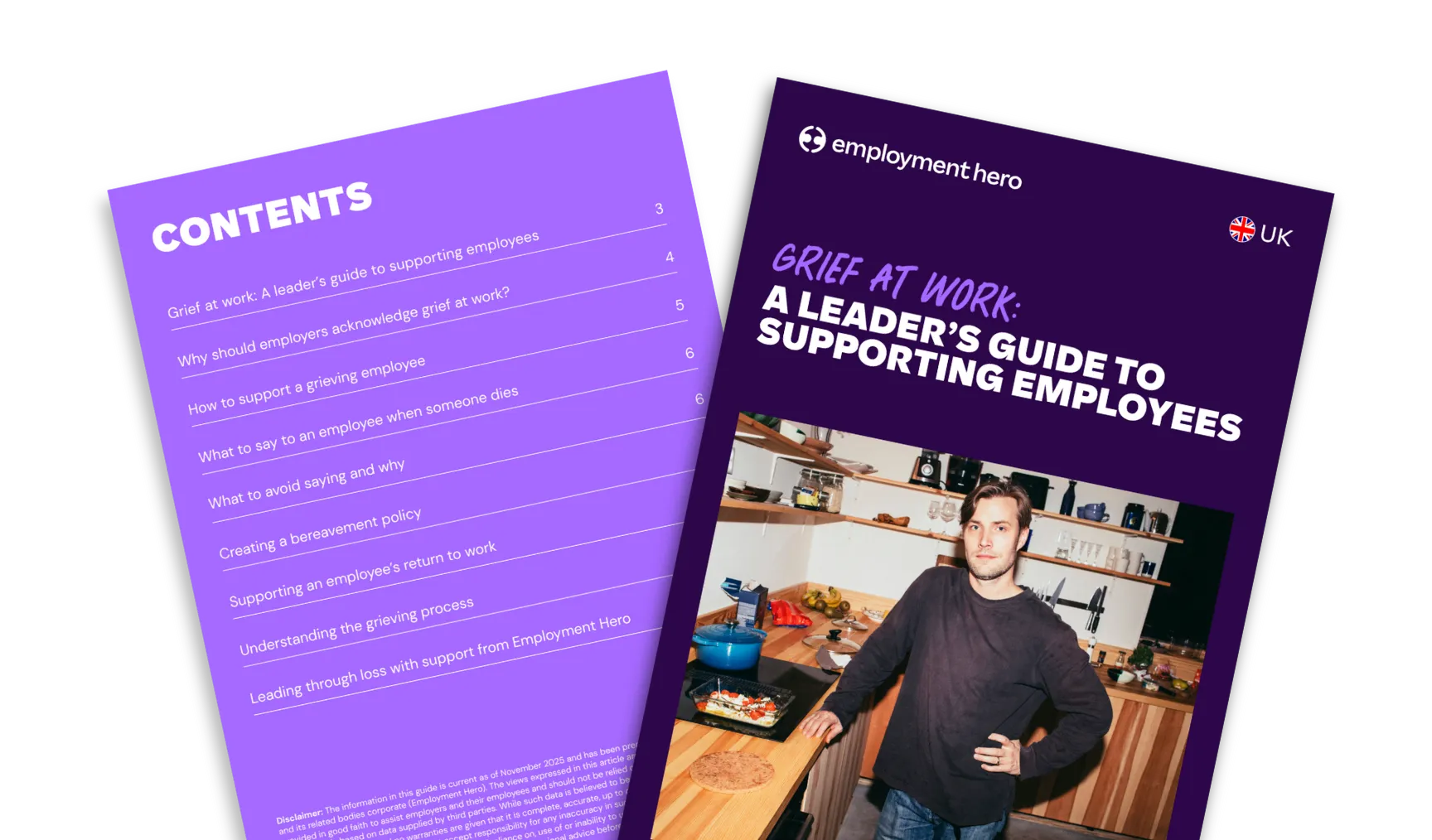Pregnancy rights at work – what employers need to know
Published
Pregnancy rights at work – what employers need to know
Published
Pregnancy is a significant life event, and employers have both a legal and moral duty to support employees during this time. Understanding pregnancy rights at work is essential to ensure compliance with UK employment law, maintain employee wellbeing, and foster a positive and inclusive workplace culture. This guide provides a detailed overview of the key legal protections for pregnant employees, employer responsibilities and examples of best practice to support staff throughout pregnancy, maternity leave and the return to work.
Whether you are a small business owner, an HR manager or a line manager, this resource will help you navigate statutory obligations and practical considerations while promoting fairness, safety, and employee engagement in the workplace. By proactively supporting pregnant employees, employers not only comply with the law but also create a more loyal and motivated workforce.
What are the four main rights a pregnant employee has?
All pregnant employees in the UK are entitled to four core rights, which apply regardless of the length of their employment. These entitlements ensure that employees can manage their pregnancy safely and without fear of disadvantage and they provide a clear framework for employers to follow. The four main rights cover paid time off for antenatal care, maternity leave, maternity pay or maternity allowance and protection against unfair treatment, discrimination or dismissal. These include:
- Paid time off for antenatal care.
- Maternity leave.
- Maternity pay or maternity allowance.
- Protection against unfair treatment, discrimination, or dismissal.
Each of these rights ensures that employees can manage their pregnancy safely and without fear of disadvantage. Employers must understand these entitlements and have processes in place to uphold them consistently.
Paid time off for antenatal care
Pregnant employees have the right to take time off for antenatal appointments, which include routine check-ups, scans and any medical appointments and classes recommended by a doctor, midwife, or health visitor. This also covers antenatal classes or parentcraft sessions if they are recommended by a doctor or midwife, e.g. relaxation classes or parenting classes. Employers must provide paid time off for these appointments and ensure the hours taken are treated as normal working time. While employees should provide reasonable notice of appointments, they are not required to provide detailed explanations of their medical visits. Employers may request evidence, such as an appointment card or letter, to confirm the time off.
Scheduling these appointments fairly is essential to avoid penalising employees or affecting performance evaluations. Flexible arrangements, such as adjusted start and finish times or shift swaps, can help balance business needs with employee wellbeing. Organisations can also benefit from digital tools to manage leave efficiently, ensuring both compliance and a smooth operational flow. For further guidance on managing leave for pregnancy and other life events, Employment Hero’s Leave Management Software provides practical solutions to track, approve, and record employee leave with ease.
For more guidance on managing leave for pregnancy and other life events, learn more about our Leave Management Software.
Maternity leave
Statutory maternity leave entitles employees to up to 52 weeks of leave, which is divided into:
- Ordinary maternity leave – the first 26 weeks.
- Additional maternity leave – the following 26 weeks.
Maternity leave can begin 11 weeks before the expected week of childbirth, providing employees with flexibility and security in planning for the arrival of their child.
Employees must give written notice of their intended leave start date and expected week of childbirth. Employers, in turn, should ensure that their maternity leave policies align with wider parental leave arrangements and clearly outline procedures for returning to work. Maintaining clear communication during leave planning helps to manage workloads, ensure business continuity and support the employee’s smooth transition back into their role.
Detailed guidance on statutory maternity leave can be found in our Employers Guide to Maternity Leave.
Maternity pay or maternity allowance
Employees may be eligible for statutory maternity pay (SMP) or maternity allowance, depending on their employment status and earnings.
Statutory Maternity Pay (SMP)
Statutory maternity pay is available for up to 39 weeks, typically paid at 90% of the employee’s average weekly earnings (before tax) for the first six weeks.Followed by a standard SMP rate (or 90% of the average weekly earnings if this is lower) for the remaining 33 weeks. Employers are responsible for processing SMP through payroll and maintaining accurate records to ensure compliance and avoid errors.
Maternity Allowance
Maternity allowance is available to employees who do not meet SMP eligibility requirements and is paid directly by HMRC. To be eligible, individuals must have been employed or self-employed for at least 26 weeks in the 66 weeks before the baby is due, and have earned a minimum average amount set by HMRC. Employers should provide guidance to staff on how to apply and maintain proper records for transparency.
Integrating maternity pay administration with automated payroll systems can reduce mistakes, streamline processes and ensure employees receive their entitlements efficiently. For additional support, Employment Hero’s guide on Understanding Parental Leave provides insights into managing maternity payments and leave arrangements effectively.
Employers can integrate maternity pay administration with automated payroll systems to reduce errors and improve efficiency. For related guidance, see our factsheet on Understanding Parental Leave.
Protection against unfair treatment, discrimination or dismissal
Employees are legally protected from any unfavourable treatment connected to pregnancy or maternity under the Equality Act 2010. Protections cover dismissal, redundancy, performance management, and access to training or promotion opportunities.
Examples of unlawful treatment include:
- Denial of promotion or career progression because of pregnancy.
- Exclusion from training, development, or networking opportunities.
- Redundancy decisions motivated by maternity leave.
- Negative performance ratings, withheld bonuses, or penalisation for flexible working requests.
- Victimisation for raising concerns about pregnancy or maternity rights.
Employers should ensure decisions are objective, evidence-based, and free from bias. Best practice involves maintaining clear written policies, training managers to recognise and prevent discrimination, documenting decisions, and offering reasonable adjustments, such as flexible hours or workload changes.
Consulting HR or legal guidance when unsure of compliance reduces legal risk and helps protect employees. Treating pregnancy fairly supports wellbeing and fosters engagement.
Understanding pregnancy-related illnesses
Pregnancy can sometimes result in health conditions that prevent employees from working temporarily. These may include severe morning sickness, gestational diabetes, high blood pressure, pre-eclampsia, or complications requiring bed rest.
Employers must treat these absences sensitively and fairly, ensuring employees are not treated less favourably than others experiencing sickness absence Pregnancy-related illnesses should be recorded as sickness absence, but it must not be counted towards absence triggers, disciplinary procedures, or performance management procedures.
Medical evidence may be requested if necessary, but must be handled confidentially and in line with data protection obligations. Communication between employee and manager is crucial for planning workload adjustments and avoiding misunderstandings.
Recording and managing absence
- Pregnancy-related illnesses should be recorded as sickness absence, but must not be treated less favourably than other illnesses.
- Employers can request medical evidence if necessary, but this should be handled sensitively, confidentially and only reasonably required.
- Clear communication between employee and manager helps plan workload adjustments and avoid misunderstandings.
Employer responsibilities
- Ensure employees are not penalised in performance reviews, promotion opportunities, or redundancy decisions due to pregnancy-related illness.
- To support the employee’s health and safety, make reasonable adjustments where needed, such as flexible working hours, temporary role changes, or additional breaks.
- Maintain awareness of return-to-work planning to support a smooth transition once the employee is fit to resume their duties.
Recognising pregnancy-related illnesses promotes a supportive workplace culture while ensuring legal compliance. Employment Hero’s Sick Leave Entitlements provides further guidance.
Understanding compulsory maternity leave
Following childbirth, all employees are required to take a compulsory period of maternity leave. This period is two weeks for most employees, or four weeks for factory workers, immediately after the birth. During this time, the employee is not permitted to work, and employers must ensure they are fully supported.
Employers must:
- Inform employees: Ensure staff know their rights regarding compulsory leave as part of maternity leave communications.
- Maintain pay: Statutory maternity pay (SMP) must continue during this period for eligible employees.
- Plan workloads: Adjust schedules or redistribute tasks to cover the absence without penalising the employee.
- Support return to work: Maintain contact where appropriate to plan a smooth transition back to work, including any adjustments needed for health, wellbeing, or childcare responsibilities.
Employers should view this period as an opportunity to review policies, update risk assessments, and prepare for the employee’s return while respecting their right to rest and recover.
Health and safety for pregnant employees
Employers have a legal duty under the Management of Health and Safety at Work Regulations 1999 to ensure the safety of pregnant employees. This includes conducting pregnancy-specific risk assessments and making adjustments where necessary to protect both the employee and their unborn child.
Conducting a pregnancy risk assessment
A risk assessment should:
- Identify tasks, environments, or conditions that could pose a risk to a pregnant employee.
- Consider physical, chemical, biological, and ergonomic hazards.
- Review workload, working hours, and stress levels.
- Be updated regularly throughout pregnancy, as risks may change over time.
Documentation is important to show compliance and support any adjustments made. Employers should record findings, actions taken, and review dates to ensure ongoing safety.
Suspension to protect health and safety
If a risk is identified, employers must take all reasonable steps to remove or reduce it. This may involve adjusting working conditions or hours, or offering suitable alternative work on the same terms and conditions.
If no suitable alternative work is available, the employee must be suspended on maternity grounds for as long as necessary to protect their health and safety. Any such suspension should be on full pay, unless the employee unreasonably refuses an offer of suitable alternative work. If the baby is due in less than 4 weeks, the maternity leave will start automatically.
Employers should maintain open communication with the employee, explaining the reasons for any suspension, anticipated review dates, and options for alternative duties. All decisions should be carefully documented to demonstrate compliance and fairness.
Common safety risks for pregnant employees
Pregnancy can make employees more vulnerable to certain workplace hazards. Employers have a responsibility to identify risks and make reasonable adjustments to protect the health and safety of pregnant staff and their unborn child. Common safety risks include physical strain, exposure to harmful substances, prolonged standing or sitting, and excessive working hours.
Heavy lifting or carrying
Manual handling tasks, including lifting or carrying heavy items, can pose a risk of injury or strain during pregnancy. Employers should:
- Conduct a risk assessment of any manual handling tasks assigned to pregnant employees.
- Provide mechanical aids, trolleys, or lifting equipment wherever possible.
- Reassign tasks to colleagues or modify duties to reduce physical strain.
- Offer training and guidance on safe lifting techniques if handling is unavoidable.
By addressing these risks proactively, employers can prevent injury and demonstrate compliance with health and safety obligations.
Standing or sitting for long periods without adequate breaks
Extended periods of standing or sitting can lead to discomfort, swelling, fatigue, and circulation issues for pregnant employees. Employers should:
- Introduce task rotation or allow short, frequent breaks.
- Provide ergonomic chairs, footrests, or supportive equipment for seated roles.
- Consider flexible working arrangements, such as adjustable start and finish times or temporary role modifications.
These adjustments help maintain wellbeing while ensuring productivity and continuity of work.
Exposure to toxic substances
Certain environments may expose employees to harmful chemicals, fumes, or biological hazards that could affect pregnancy. Employers should:
- Identify high-risk areas, such as laboratories, cleaning or chemical handling zones, and manufacturing processes.
- Provide personal protective equipment (PPE) and ensure proper training on its use.
- Temporarily reassign duties if exposure cannot be eliminated.
- Maintain clear communication with employees about potential hazards and protective measures.
This proactive approach helps prevent health risks while demonstrating a commitment to workplace safety.
Long working hours
Excessive working hours, fatigue, or high-pressure workloads can have negative effects on both maternal and foetal health. Employers should:
- Review schedules and workloads to prevent overexertion.
- Allow flexible working options, including reduced hours, adjusted shifts, or remote work where possible.
- Monitor employee wellbeing and encourage open dialogue about fatigue or stress.
By balancing business needs with employee health, employers reduce risk and support a positive working environment for pregnant staff.
What counts as pregnancy and maternity discrimination?
Pregnancy and maternity discrimination occurs when an employee is treated less favourably because of pregnancy, childbirth or maternity leave, rather than for general performance or workplace issues. This is different from general unfair treatment, which may affect any employee regardless of pregnancy status.
Unlawful actions may include the following examples:
- Refusal to promote: Denying a promotion or career progression opportunity because an employee is pregnant or planning maternity leave.
- Exclusion from training or development: Preventing attendance at training courses, conferences, or professional development programs due to pregnancy.
- Redundancy decisions linked to pregnancy: Selecting an employee for redundancy primarily because they are pregnant or have recently returned from maternity leave.
- Negative performance management: Giving lower performance ratings, withholding bonuses, or penalising flexible working requests due to pregnancy or maternity leave.
- Victimisation: Treating an employee unfairly for raising concerns about pregnancy or maternity rights.
Employers must ensure that all decisions are based on objective, evidence-based criteria and not influenced by pregnancy or maternity status. Failure to comply can lead to legal claims under the Equality Act 2010 and reputational damage.
What should employers do if they’re unsure about compliance?
When in doubt, employers should seek expert guidance to reduce legal risk and ensure fair treatment. Consulting HR or legal specialists helps clarify entitlements and obligations. Reviewing internal policies, ensuring they are up to date, and using standardised templates for leave requests, risk assessments and adjustments promotes consistency. Accurate documentation of decisions and adjustments also demonstrates fairness. Employment Hero offers practical resources, templates and tools to streamline leave management and ensure compliance.
Support your employees through pregnancy and beyond
Pregnancy and parenthood bring unique challenges for employees and employers alike. Staying on top of legal obligations, health and safety requirements, and fair workplace practices is essential for compliance and employee wellbeing. Employment Hero provides the tools and guidance you need to make managing pregnancy, maternity and parental leave simple and stress-free.
Download the Parents at Work Guide to access all the resources you need to support your employees and ensure your business remains compliant. Employment Hero helps you streamline leave management, protect your team and create a supportive workplace culture every step of the way.
To download the guide, we just need a few quick details.
Related Resources
-
 Read more: How to Create Bespoke E-Inductions For New Hires And Contractors
Read more: How to Create Bespoke E-Inductions For New Hires And ContractorsHow to Create Bespoke E-Inductions For New Hires And Contractors
Learn how to design bespoke e-inductions for new hires and contractors. Discover flexible, learner-centred solutions to improve onboarding and retention.
-
 Read more: Power Your Accounting Firm with Employment Hero
Read more: Power Your Accounting Firm with Employment HeroPower Your Accounting Firm with Employment Hero
Join the Employment Hero Accounting Partner Programme. Earn commission, access exclusive support and help SMEs simplify HR and payroll management.
-
 Read more: Grief at work: A leader’s guide to supporting employees
Read more: Grief at work: A leader’s guide to supporting employeesGrief at work: A leader’s guide to supporting employees
Learn how to support grieving employees and create a compassionate workplace. Discover what to say, what to avoid, and how…



















